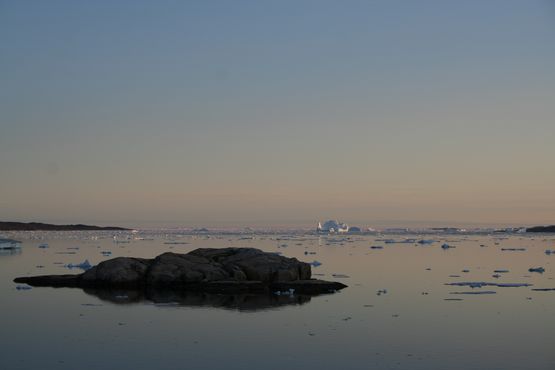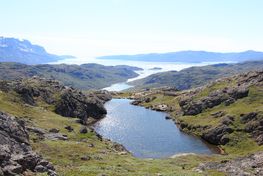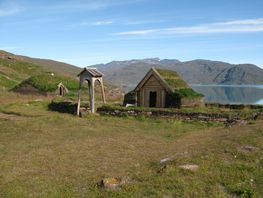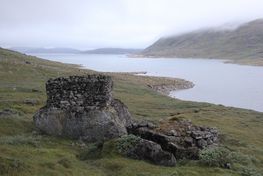More about: The Vessel | The Crew | The History | Video | Photos.
The history
The story of the discovery of Greenland is among the best-known tales in the Islandic Sagas. Voyages across open sea took courage and curiosity, experience at sea and an intimate knowledge of navigation. If the ship reached their destination safely, tales of recognition and respect were told about the adventurers.
The Vikings were familiar with seeking happiness 'on the other side of the sea'. Population pressure, lack of good farmland, punishment in the form of exile, the dream of freedom, rumours of foreign shores and the desire to make new discoveries have, through the centuries. led the Vikings out into the unknown.
Erik the Red
In 982, the Thing assembly at Breiða Fjord on Iceland decided the fate of the Norwegian Erik the Red. Intense disputes with a neighbour led to several murders, and Erik the Red was banished for three years.
He [Erik] told them he meant to look for that land Gunnbjorn, Ulf-Krakuson sighted the time he was stormdriven into the western ocean and discovered Gunnbjorn's skerries. He would be coming ack, he said, to make contact with his friends should he discover that land.
From the Saga of Erik the Red, 13th century
After three years as an outlaw Erik the Red returned. With him he brought stories of deep fjords and fertile, uninhabited land. Later that same year, 25 ships sail toward the new land... calling it Greeland, for he maintained that men would be much more eager to go there if the land had an attractive name.
From the Saga of Erik the Red, 13 th century
The voyage
The climate on the North Atlantic was milder when the first colonists sailed from Iceland to Greenland in late 10th century. However, despite summers with favourable wind and long hours of daylight and seaworthy ships, the route across open sea was not without risk. Sagas tells of ships that went down, drifted back the way they had come or lost their course and risked getting caught on open sea for a prolonged period.
The voyages were undertaken in large seaworthy, ocean-going ships with high loading capacity. The Saga of Erik the Red and Greenlendiga Saga tell of crews of 30-40 men - whole families miving their life; provisions for several days without land in sight, weapons and tools, licestock for supply and reeding as well as other practical necessities to start a new life, in an unknown place.
The Vikings knew of north, south, east and west. By reading nature; wildlife, the changing colours of the sea, land marks and the sun, moon and starts they could set and hold a course. And some Viking tales and rhymes included sailing directions. The voyage to Greeland was described as:
From Hernar [present day Bergen] in Norway, head due west towards the Hvarf in Grenland. Then you sail north of Hjaltland [Shetland Islands], so that you just glimpse it in good visibility, then south of the Faroe Islands, so that the horizon of the sea is on the middle of the mountainsides, and thus also south of Iceland that you see coastal bound birds and whales.
Hauksbóks edit of Landnámabók, 14th century
Norse life
Erik has since taken Erik's Fjord in possesion and settled in Brattahlið.
From Landnámabók, 12th century
Erik the Red established the seat of his chieftaincy in the south (The Eastern Settlement). Other ships continued north along the coast and established the Western Settlement, close to present day Nuuk. Tales of the new land gave hope of a better life and drew more and more people across the sea to Greeland.
From 1000-1500 AD the Viking's northern colonies expanded. The population grew, new settlements shot up and cattle, sheep and goats grazed on the pastures of the outer fjords. Wood, iron and pottery from Iceland and Europe were traded with luxury goods from Greenland, such as hides and walrus tusk.
The approx. 2.500 Norsemen lived scattered over thousand of kilometres and adjusted to the landscape more succesfully than has previous been assumed. New studies show that they coped for a long time with the climate changes of 'The little Ice Age' around 1250. The landscape became barren, cattle died and storms kept the Norwegian trading ships away from Greenland's coasts. The Norsemen slowly went from agriculture to hunting and fishing. Outlying farms were abandoned, power and resources centralsied around the largest farms and the difference between rich and poor increased. However, the last people of the Eastern Settlement did not dissappear until 250 years later.
Today there are several traces of Norse life on Greenland to be found in the landscape. Ruins of boat houses lie along the coast and testify to the importance of seafaring in terms of maintain contact between the settlements. Ruins of farms, warehouses, churches and an episcopal residence, all placed at natural harbours and bays, are today seen as nodal points in the Norse Greenland trade.



